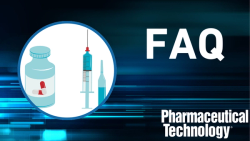
OR WAIT null SECS
- About Us
- Advertise
- Contact Us
- Editorial Info
- Editorial Advisory Board
- Do Not Sell My Personal Information
- Privacy Policy
- Terms and Conditions
© 2025 MJH Life Sciences™ , Pharmaceutical Technology - Pharma News and Development Insights. All rights reserved.
Injecting Highly Viscous Drugs
The author reviews the challenges in delivering macromolecule biologics.
It’s been 61 years since Watson and Crick published “A Structure for Deoxyribose Nucleic Acid” in the April 1953 issue of Nature. Nineteen years later, Paul Berg’s team at Stanford University created the world’s first recombinant DNA molecule. In 1976, Swanson and Boyer founded Genentech. In 1982, Eli Lilly launched Humulin, the first human insulin produced using recombinant DNA technology, developed by Genentech. Since the 1990s, biologic drugs have been the center of attention for the pharmaceutical world, both in terms of therapeutic opportunity and of business activity.
EvaluatePharma World Preview 2014 predicts global sales of prescription drugs are expected to exceed $1 trillion by 2020 (1) of which more than 50% are expected to be biological products, dominated by monoclonal antibodies. But just like insulin, these protein-based drugs are rendered useless if taken orally. A means of delivery other than a tablet or capsule is, therefore, called for, and there are challenges associated with it.
Size is important
People with diabetes have been successfully injecting themselves with insulin, often several times each day, for more than 90 years. It might be expected that self-injection of any other drug should be as straightforward. However, it is not quite that simple. Insulin, with a molecular weight of 5.8 kDa, is a rather large molecule when compared with drugs such as aspirin (at 180 Da) or even penicillin (at around 335 Da).
Now consider Humira, a hugely successful product used to treat a range of autoimmune conditions, including rheumatoid arthritis, ankylosing spondylitis, and Crohn’s disease. It has a molecular weight of approximately 148 kDa. Humira (C6428 H9912 N1694 O1987 S46) is 25 times the size of the insulin molecule and is anything but simple. The high mg per mL concentrations of these macromolecule drugs result in high enough viscosities of the injectable product to cause problems for device designers, manufacturers, primary container suppliers, and patients.
What are the practical options?
The cost and convenience drivers for self-administered therapies, especially for chronic conditions, result in regular but infrequent injections of relatively large payloads of molecules, injected weekly, possibly fortnightly, or even quarterly. Injection of 1 mL in a single, self-administered dose has historically been regarded as the upper threshold of acceptability, but single injected doses of up to 2.5 mL are now being actively explored. Discomfort or pain are major considerations, but time also forms a part of the equation. In general, patients don’t want to hold an autoinjector (an increasingly common delivery device format for biological drugs) in place for more than 15 seconds, a time window that includes needle insertion as well as the actual injection.
Syringeability
Syringeability refers to the force required to inject a given solution at a given rate via a chosen needle length and gauge. Flow through a hollow needle is characterized by the Hagen-Poiseuille equation:
Although syringe plunger friction and tissue resistance at the needle tip will add to syringe plunger force, viscous resistance within the needle is particularly relevant as larger molecules and higher mg/mL concentrations result in higher viscosity formulations. Needle gauge is key; although a finer needle means easier and less painful insertion, it also has a smaller bore. Equation 1 shows that plunger force varies with D4. If an injector device is fitted with a 27 G needle (bore size 0.191 mm) and the needle is changed to a 30 G (bore size 0.140 mm) of the same length, the plunger force needed to give the same flow rate (Q) (and therefore the same injection duration) has to increase by 350%.
For a spring-powered autoinjector, the spring must provide adequate force at the end of stroke (as the last drop of drug is delivered). However, the stiffness or rate of a traditional coil spring dictates that at the start of delivery, the spring force will be significantly higher. Add on the syringe plunger friction and tissue resistance, plus a safety margin to allow for tolerances, and it becomes apparent that some surprisingly high forces have to be handled by the injector mechanism and, specifically, reacted through the prefilled syringe (usually of type 1 borosilicate glass) at the heart of the autoinjector. Not surprisingly, breakages, failures, and malfunctions are among the problems faced by autoinjectors delivering higher viscosity biologic drugs.
At this point, it should be emphasized that the rules of fluid dynamics cited, though applicable for a great many situations, are only strictly valid for Newtonian fluids (i.e., those for which shear rate is directly proportional to flow rate). So-called “ideal fluids” exhibit zero stress under any flow conditions. At the opposite extreme, ideal solids do not flow under any conditions. Between these two extremes, Newtonian fluids, exhibiting a neat, straight-line relationship are joined by other, non-Newtonian fluids that exhibit non-linear behaviors:
- ‘Dilatant’ fluids exhibit shear-thickening behavior, for example, cornflour mixed with water goes from liquid to solid when trying to stir the mix.
- ‘Pseudoplastic’ or shear-thinning fluids, such as tomato ketchup, become mobile and free-flowing when shaken. This group includes blood and high concentration formulations of high molecular weight drugs.
Andrea Allmendinger of Hoffman-La Roche presented a paper (2) looking into this topic with regard to high-concentration, large-payload macromolecule drugs at the Parenteral Drug Association Universe of Prefilled syringes in Basel, November 2013. This paper illustrated how complex the subject can be, but made interesting reading. The statistician George Box once stated “Essentially, all models are wrong, but some are useful,” and this view has strong resonance when exploring viscous product delivery with a syringe and needle.
Although there may be some rheological assistance due to shear thinning during injection for some products, a variety of approaches to reduce delivery challenges are actively being pursued. These approaches include thin-walled or tapered needles to reduce viscous resistance and minimize pain; constant force springs and dampers to minimize peak forces; precisely moulded cyclic polyolefin syringes, which are more robust than glass; and reduced friction stoppers and syringes. But why not just change the approach to injected delivery and side-step some of these challenges?
Large-volume injectors
If we treat injection time as an opportunity, not a challenge, it presents an interesting device scenario. When applying the Hagen-Poiseuille equation for an autoinjector, the flow rate (Q) in Equation 1 of 1 mL or 2 mL in perhaps 10 seconds is driven largely by the acceptable operating time for the patient. But if the injection device could be worn for 15 minutes during delivery, then the flow rate for the same injection size reduces by 9000%—and Equation 1 tells us that the plunger force would reduce in the same ratio. In fact, the drug formulation could be less concentrated (and less viscous), though of larger volume (e.g., 5 mL), while the flow rate and force to deliver would remain manageable. This is the operating territory for the large-volume injector (LVI) or bolus delivery device.
A number of devices of this type are in development, which use a variety of primary containers (glass, plastic, flexible, rigid, traditional, and novel variants) and a range of mechanisms, power sources, and control systems (mechanical, electrical, electronic, hybrid). The LVI addresses some of the key challenges confronting the autoinjector and much effort is being devoted to the technical, pharmaceutical, and user-related aspects of LVI devices.
Needle-free delivery
Needle-free delivery has been a reality since the late 1940s, and several technologies are now available. Needle-free delivery uses a fine, high velocity jet generated by driving liquid through an orifice at high pressure to pierce the skin and underlying tissue. The governing equation (by Bernoulli) can be rearranged as shown in Equation 2.
Comparing this with Equation 1, the only fluid property in the Bernoulli equation is ρ (density) and there is no viscosity term. Because drug formulations generally have densities close to that of water, the implication is that a needle-free device will deliver the same volume, at the same rate, using the same energy, largely irrespective of viscosity.
Strictly speaking, this holds true for orifice plates of zero length and hence is not the only governing relationship for a practical, real-life device. Nevertheless, although practical orifii do have a finite length and do exhibit some viscous loss, needle-free devices are largely unaffected by product viscosity in the practical range of interest, as Figure 1 illustrates.
Which to choose?
All three injection technologies discussed have their place, but selection is often left until late in the development of the drug product, which can mean that opportunities can be missed. Early exploration of formulation options together with the increasingly wide range of real, practical options for parenteral delivery can provide significant benefits to everyone from the pharmaceutical company to the patient.
References
- EvaluatePharma World Preview 2014, Outlook to 2020, accessed Oct. 2, 2014.
- Andrea Allmendinger, “Injection forces during subcutaneous drug administration,” presentation at the Parenteral Drug Association Universe of Prefilled Syringes (Basel, November 2013).
About the Author
Andy Fry is the founder of Team Consulting, andy.fry@team-consulting.com.
Related Content:



